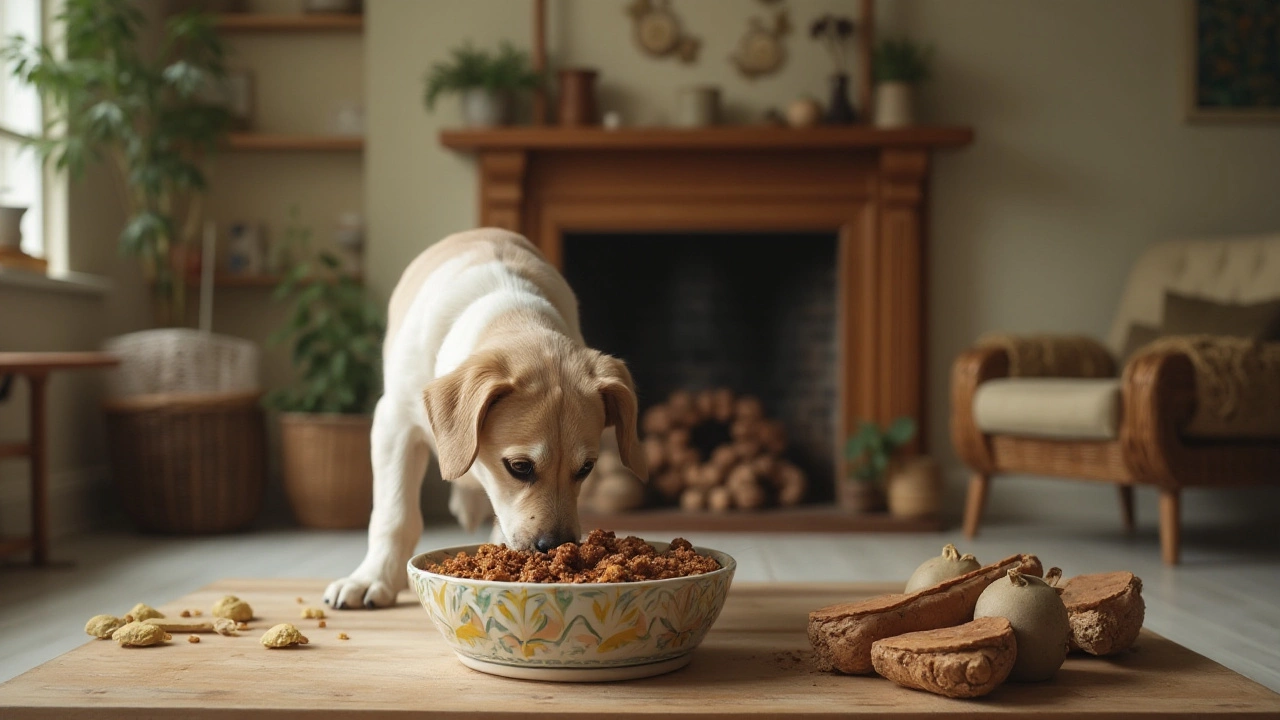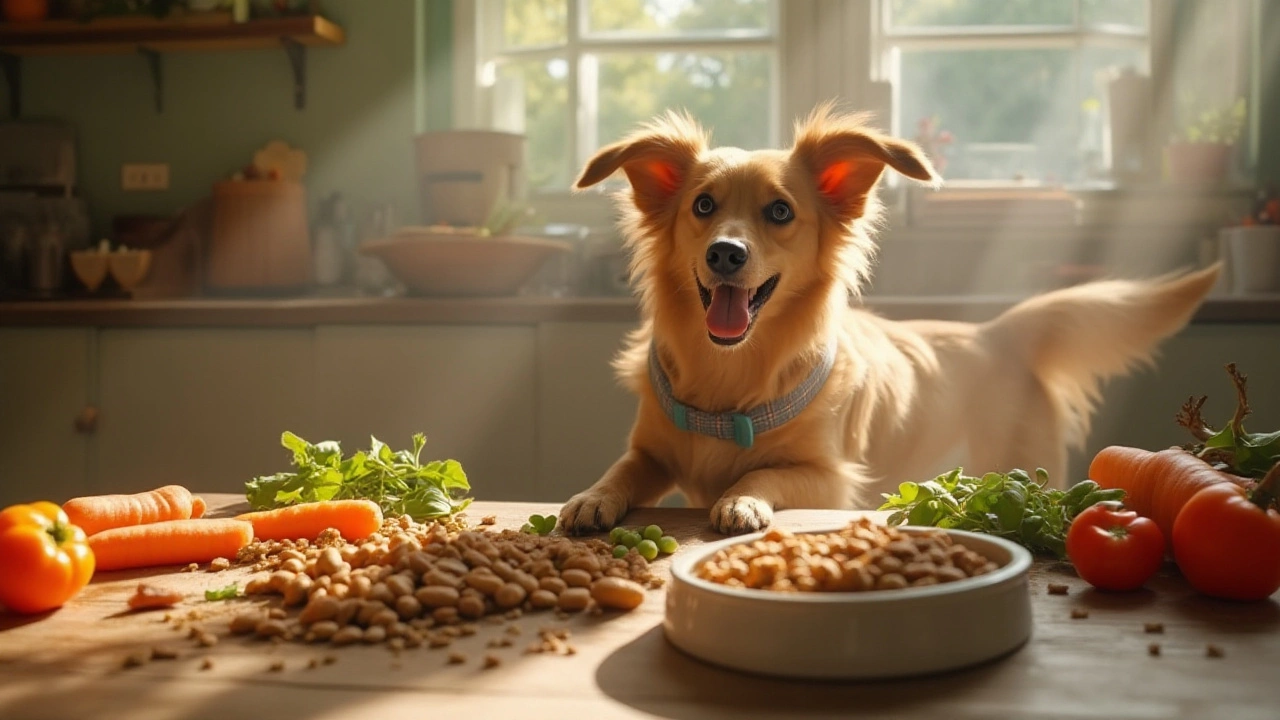Feeding your dog a healthy, balanced diet is essential for their well-being. Yet, many pet owners are concerned about the high cost of commercial dog food. The good news is that feeding your dog real, wholesome food doesn't have to be expensive.
By learning about canine nutritional needs and choosing cost-effective ingredients, you can create meals that are both delicious and nutritious for your furry companion. Let's explore how you can keep your dog's diet healthy and your expenses in check.
- Understanding Canine Nutrition
- Budget-Friendly Ingredients
- Preparing Homemade Dog Meals
- Tips to Save Money on Dog Food
Understanding Canine Nutrition
Before embarking on the journey of preparing homemade meals for your dog, it's crucial to grasp the fundamentals of canine nutrition. Dogs, unlike humans, require a unique balance of nutrients to maintain their vitality. Protein is essential for them as it supports muscle development and energy. Unlike cats, who are obligate carnivores, dogs can process both plant and animal proteins, making it easier to diversify their diets even when on a budget.
Carbohydrates are another important aspect, playing a vital role in supplying energy. While some think dogs thrive solely on meat, carbohydrates found in vegetables and grains can provide beneficial energy and fiber that aid digestion. Vets often recommend brown rice and oats as affordable carbohydrate options that can be easily incorporated into dog meals.
Fats, though often misunderstood, are essential. They aid in nutrient absorption and provide the fatty acids necessary for keeping your dog's coat shiny and skin healthy. Fish oil and chicken fat are common sources. However, moderation is key, as too much fat can lead to obesity, an issue that is surprisingly prevalent among pets today. According to the Association for Pet Obesity Prevention, over 55% of dogs in the US are overweight.
Equally important are vitamins and minerals, found abundantly in green leafy vegetables and fruits. They promote overall health and immunity. Through balanced meals, including small amounts of foods like carrots and spinach, dogs can enjoy varied flavors while ensuring they get these vital nutrients. Dr. Karen Becker, a renowned integrative wellness veterinarian, once said,
"The best diet for dogs is one that is fresh and minimally processed. Just like for humans, real food is generally the most nutritious."
One cannot emphasize enough the role of water in a dog's diet. Water constitutes about 60% of a dog's body weight, and it plays a critical role in maintaining body temperature and facilitating digestion. Dogs, much like people, require regular hydration to stay healthy and active. Conveniently, homemade meals often have higher water content compared to kibble, which can help maintain adequate hydration levels naturally.
Understanding these nutritional elements can empower you to create balanced and healthy meals that not only meet your dog’s needs but also save money. Take the time to explore different ingredients, experiment with combinations, and observe how your dog responds to certain foods. Every dog is unique in its dietary preferences and tolerances, so it may take a bit of trial and error to craft the perfect diet. But, with patience and a keen eye on your dog's health changes, you can successfully feed your dog with homemade dog food that is as affordable as it is nourishing.

Budget-Friendly Ingredients
When it comes to preparing homemade dog food, choosing the right ingredients is crucial. Your dog's diet should be a blend of proteins, carbohydrates, and healthy fats to ensure they get all the necessary nutrients. Fortunately, you don't have to spend a fortune to accomplish this. Let's explore some budget-friendly ingredients that can make your dog meals both nutritious and affordable.
First on the list is chicken, which is an excellent source of lean protein. Not only is it rich in essential amino acids, but it's also one of the most affordable meats you can buy. Look for sales at local grocery stores or consider purchasing in bulk to save even more. In addition to chicken, ground turkey is another cost-effective protein source that provides similar benefits. Rotating between these proteins can help keep your dog's diet varied and interesting.
Whole grains like brown rice and oats are fantastic for providing necessary carbohydrates. Brown rice is filled with fiber, which aids in digestion and keeps your dog feeling full. Oats, similarly, are a great source of fiber and are often more affordable than rice. Cooking a large batch and storing it in the refrigerator for the week is a time-saving idea. For those who prefer to avoid grains, sweet potatoes are an alternative, providing both carbs and important vitamins.
Vegetables are an essential part of a dog's diet, providing vitamins and minerals that aren't found in meat and grains. Carrots, peas, and green beans are not only affordable but also packed with nutrients. These vegetables are easy to prepare and can be served cooked or raw, depending on what your dog prefers. When shopping for vegetables, try to buy what's in season, as these tend to be cheaper and fresher.
Affordable dog food can also include eggs, which are a wonderful protein-packed supplement. They are versatile and can be incorporated into various meal types, from scrambled to boiled. Eggs are high in fats that are beneficial for your dog's coat and skin. Another inexpensive protein source is plain yogurt, providing probiotics that can support digestive health without breaking the bank.
Finally, don't overlook the power of organ meats like liver, which are affordable and nutrient-dense. While it shouldn't become the primary protein in your dog's diet due to its rich nature, incorporating it occasionally can provide a great nutritional boost. Consider adding small portions to meals every now and then to keep your pet excited and healthy. According to Dr. Karen Becker, "Organ meats should make up 10% of your dog's diet. They’re like nature's multivitamins."

Preparing Homemade Dog Meals
Creating homemade meals for your dog can be a fulfilling and gratifying experience, both for you and for your beloved pet. When preparing these meals, understanding your dog's nutritional needs is essential. Dogs thrive on a diet that offers a balance of proteins, carbohydrates, fats, vitamins, and minerals. To achieve such a balance, you should vary the ingredients you use. Meat is often a staple, with options like chicken, beef, or turkey being common due to their cost-effectiveness and nutritional value. However, rotation among these can prevent dietary boredom and provide a wider range of nutrients. Carbohydrates come from brown rice or sweet potatoes, offering energy and fiber, while vegetables like carrots and peas supply necessary vitamins without adding too many calories.
When cooking homemade dog food, it's important to leave out seasonings and ingredients like onions, garlic, and chocolate which are toxic to dogs. Instead, focus on simplicity. Generally, meals are cooked without salt or spices. For fats, small amounts of olive oil added after cooking help maintain your dog’s coat and energy. One helpful tip is to prepare meals in larger batches and freeze portions for convenience.
"A well-balanced diet is critically important for your dog’s health and longevity," says Dr. Karen Becker, a proactive and integrative wellness veterinarian. "Home-prepared meals are a wonderful way to control both the quality and freshness of the diet you feed your pet."Keep that in mind as you delve into the realm of cooking for your pet, and always strive for balance.
As you cook, keep portion sizes appropriate for your dog’s size, age, and activity level. Consulting with a vet is always a smart move to determine exact requirements. For beginners, starting with a basic recipe can ease the process. A simple meal might include approximately 40% protein, 50% vegetables, and 10% grain. Transforming these percentages into a recipe could look like 1 cup of cooked lean chicken, 2 cups of vegetables, and half a cup of brown rice. As mentioned earlier, freezing is a great strategy.
Maintaining the nutritional content is crucial, but so is passion and creativity. Use the kitchen as a relaxing place to experiment and discover new recipes to make with the assortment of budget-friendly ingredients available. Soon enough, not only will you find more examples of affordable dog food but also reduce waste from leftovers. These practices will become second nature in providing for your pet and in helping both your wallet and your dog’s health.

Tips to Save Money on Dog Food
Feeding your dog on a budget doesn't mean compromising their health and nutrition. There are plenty of ways to provide tasty and nutritious meals without breaking the bank. A little creativity, careful planning, and some savvy shopping are all it takes. One of the key approaches is to buy in bulk. Purchasing larger bags of dog food or buying meat and vegetables in bulk during sales can help save a significant amount of money over time. Freezing these items and defrosting them as needed can keep everything fresh and ready for meal prep. This method works well for both dry kibble and making homemade meals.
A second strategy is incorporating seasonal produce into your dog's diet. Seasonal vegetables and fruits often cost less because they're abundant and local. Consider adding carrots, pumpkins, and sweet potatoes in the fall, or peas and blueberries in the spring. These options can provide essential vitamins and flavors without the extra cost. It's also important to remember that not all fruits and vegetables are safe for dogs, so research or consult a vet before introducing new items.
Couponing and joining loyalty programs can also bring costs down. Many pet food manufacturers and stores offer discounts through coupons, newsletters, or loyalty programs. Some programs even provide free bags of dog food after a certain number of purchases. Signing up for these can lead to occasional surprises with significant discounts or exclusive offers.
Consider making homemade dog treats instead of buying them. There are plenty of simple and affordable recipes out there, and you likely already have the ingredients in your pantry. Just as with their meals, you have full control over the quality of the ingredients when making treats. Using budget-friendly ingredients such as oats, peanut butter, and bananas, which you might already have on hand, can yield delicious and safe treats for your dog.
Lastly, don't forget to regularly check in with your veterinarian. Regular check-ups can help ensure your dog is receiving balanced nutrition and isn't being overfed or underfed. Sometimes modifying portion sizes can lead to cost savings while still meeting your dog's dietary needs. As Veterinary Nutritionist Dr. Rebecca Remillard nicely put it, "Balanced homemade diets are achievable for committed pet owners."
Understanding what makes a meal complete for your dog can help minimize potential health issues, ultimately leading to cost savings on vet bills in the long run.
